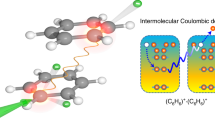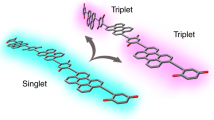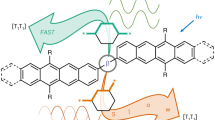Abstract
THE general properties of excited dimers, or excimers, have been well established1–4. In concentrated solutions of some polycyclic aromatic hydrocarbons, a singlet excited molecule can interact with an unexcited neighbour to produce the excited dimer, or excimer. This excimer can then break up into de-excited monomer molecules with the emission of a characteristic dimer fluorescence. The forces binding the dimer have been ascribed by Forster5 to resonance dipole interaction. The criterion has been given for excimer formation that the molecule should possess a weak 1Lb level lying beneath a strong 1La level. Most of the excimer-forming molecules obey this criterion, a notable exception being anthanthrene.
This is a preview of subscription content, access via your institution
Access options
Subscribe to this journal
Receive 51 print issues and online access
$199.00 per year
only $3.90 per issue
Buy this article
- Purchase on Springer Link
- Instant access to full article PDF
Prices may be subject to local taxes which are calculated during checkout
Similar content being viewed by others
References
Foster, Th., and Kasper, K., Z. Elektrochem., 59, 997 (1955).
Birks, J. B., and Christophorou, L. G., Nature, 194, 442 (1962).
Birks, J. B., and Christophorou, L. G., Nature, 196, 33 (1962).
Birks, J. B., and Christophorou, L. G., Nature, 197, 1064 (1963).
Forster, Th., Fifth Europ. Cong. Mol. Spec., 121 (Butterworths, London, 1962).
Hochstrasser, R. M., J. Chem. Phys., 36, 1099 (1962).
Foster, R., Tetrahedron, 10, 96 (1960).
McConnell, H., Ham, J. S., and Platt, J. P., J. Chem. Phys., 21, 66 (1953).
Birks, J. B., and Slifkin, M. A., Nature, 191, 761 (1961).
Author information
Authors and Affiliations
Rights and permissions
About this article
Cite this article
SLIFKIN, M. Charge Transfer and Excimer Formation. Nature 200, 766–767 (1963). https://doi.org/10.1038/200766b0
Issue Date:
DOI: https://doi.org/10.1038/200766b0
This article is cited by
-
Cation-π interactions enabled water-stable perovskite X-ray flat mini-panel imager
Nature Communications (2024)
-
Dilution effect for highly efficient multiple-component organic solar cells
Nature Nanotechnology (2022)
Comments
By submitting a comment you agree to abide by our Terms and Community Guidelines. If you find something abusive or that does not comply with our terms or guidelines please flag it as inappropriate.



